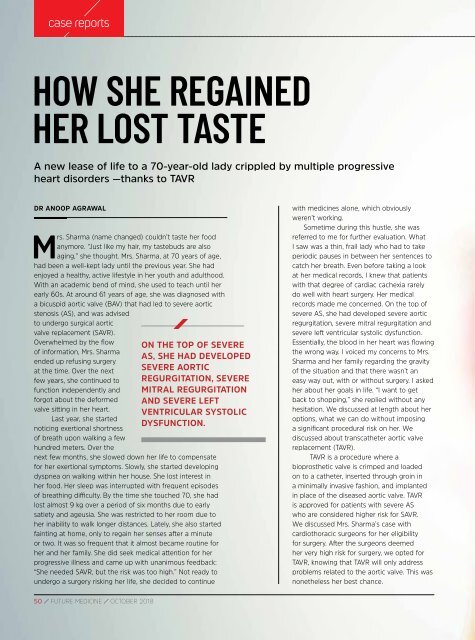Create successful ePaper yourself
Turn your PDF publications into a flip-book with our unique Google optimized e-Paper software.
case reports<br />
HOW SHE REGAINED<br />
HER LOST TASTE<br />
A new lease of life to a 70-year-old lady crippled by multiple progressive<br />
heart disorders —thanks to TAVR<br />
DR ANOOP AGRAWAL<br />
Mrs. Sharma (name changed) couldn’t taste her food<br />
anymore. “Just like my hair, my tastebuds are also<br />
aging,” she thought. Mrs. Sharma, at 70 years of age,<br />
had been a well-kept lady until the previous year. She had<br />
enjoyed a healthy, active lifestyle in her youth and adulthood.<br />
With an academic bend of mind, she used to teach until her<br />
early 60s. At around 61 years of age, she was diagnosed with<br />
a bicuspid aortic valve (BAV) that had led to severe aortic<br />
stenosis (AS), and was advised<br />
to undergo surgical aortic<br />
valve replacement (SAVR).<br />
Overwhelmed by the flow<br />
of information, Mrs. Sharma<br />
ended up refusing surgery<br />
at the time. Over the next<br />
few years, she continued to<br />
function independently and<br />
forgot about the deformed<br />
valve sitting in her heart.<br />
Last year, she started<br />
noticing exertional shortness<br />
of breath upon walking a few<br />
hundred meters. Over the<br />
ON THE TOP OF SEVERE<br />
AS, SHE HAD DEVELOPED<br />
SEVERE AORTIC<br />
REGURGITATION, SEVERE<br />
MITRAL REGURGITATION<br />
AND SEVERE LEFT<br />
VENTRICULAR SYSTOLIC<br />
DYSFUNCTION.<br />
next few months, she slowed down her life to compensate<br />
for her exertional symptoms. Slowly, she started developing<br />
dyspnea on walking within her house. She lost interest in<br />
her food. Her sleep was interrupted with frequent episodes<br />
of breathing difficulty. By the time she touched 70, she had<br />
lost almost 9 kg over a period of six months due to early<br />
satiety and ageusia. She was restricted to her room due to<br />
her inability to walk longer distances. Lately, she also started<br />
fainting at home, only to regain her senses after a minute<br />
or two. It was so frequent that it almost became routine for<br />
her and her family. She did seek medical attention for her<br />
progressive illness and came up with unanimous feedback:<br />
“She needed SAVR, but the risk was too high.” Not ready to<br />
undergo a surgery risking her life, she decided to continue<br />
with medicines alone, which obviously<br />
weren’t working.<br />
Sometime during this hustle, she was<br />
referred to me for further evaluation. What<br />
I saw was a thin, frail lady who had to take<br />
periodic pauses in between her sentences to<br />
catch her breath. Even before taking a look<br />
at her medical records, I knew that patients<br />
with that degree of cardiac cachexia rarely<br />
do well with heart surgery. Her medical<br />
records made me concerned. On the top of<br />
severe AS, she had developed severe aortic<br />
regurgitation, severe mitral regurgitation and<br />
severe left ventricular systolic dysfunction.<br />
Essentially, the blood in her heart was flowing<br />
the wrong way. I voiced my concerns to Mrs.<br />
Sharma and her family regarding the gravity<br />
of the situation and that there wasn’t an<br />
easy way out, with or without surgery. I asked<br />
her about her goals in life. “I want to get<br />
back to shopping,” she replied without any<br />
hesitation. We discussed at length about her<br />
options, what we can do without imposing<br />
a significant procedural risk on her. We<br />
discussed about transcatheter aortic valve<br />
replacement (TAVR).<br />
TAVR is a procedure where a<br />
bioprosthetic valve is crimped and loaded<br />
on to a catheter, inserted through groin in<br />
a minimally invasive fashion, and implanted<br />
in place of the diseased aortic valve. TAVR<br />
is approved for patients with severe AS<br />
who are considered higher risk for SAVR.<br />
We discussed Mrs. Sharma’s case with<br />
cardiothoracic surgeons for her eligibility<br />
for surgery. After the surgeons deemed<br />
her very high risk for surgery, we opted for<br />
TAVR, knowing that TAVR will only address<br />
problems related to the aortic valve. This was<br />
nonetheless her best chance.<br />
50 / FUTURE MEDICINE / <strong>OCTOBER</strong> <strong>2018</strong>


















